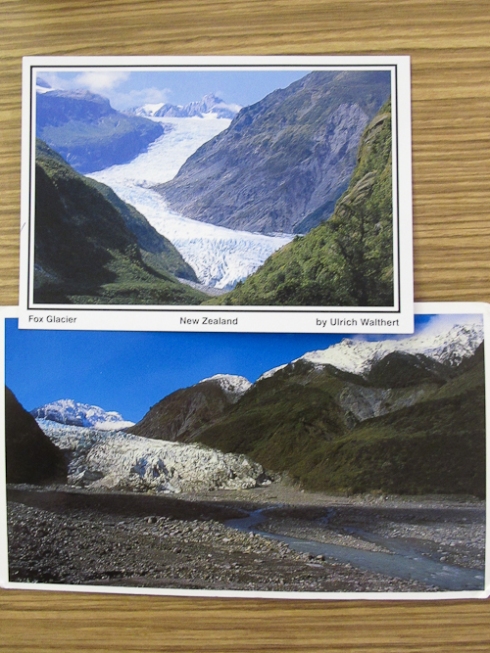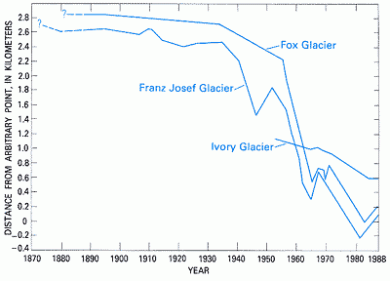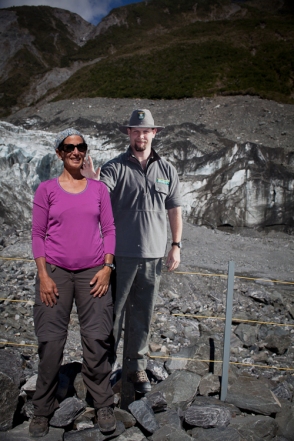When I first started researching places to photograph for this project, New Zealand was not one that came up high on the list of countries being affected by climate change. But since I had planned to go to Australia and my flight via the Star Alliance network was scheduled to go through Auckland, I decided to dig a little deeper. Although there was not a lot of news coverage about it I discovered that their two largest glaciers, The Franz Josef and the Fox in the South Island were in retreat due to global warming. And has often been the case on this journey, when I got to Aotearoa (or Land of the Long White Cloud, as the Maoris call their homeland) I learned of other climate change issues affecting New Zealand.
 I had an image in my mind of New Zealand being very mystical – both rugged with mountains and lush with mossy old-growth forests. I’m certain The Lord of the Rings movies, which were filmed there, reinforced that notion in my psyche. Thus I was a little dismayed to find so much clear-cutting of forests especially in the North Island.
I had an image in my mind of New Zealand being very mystical – both rugged with mountains and lush with mossy old-growth forests. I’m certain The Lord of the Rings movies, which were filmed there, reinforced that notion in my psyche. Thus I was a little dismayed to find so much clear-cutting of forests especially in the North Island.
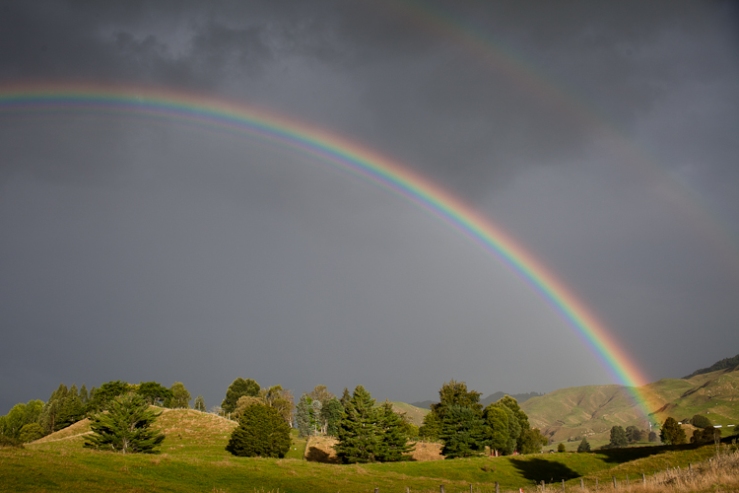 Despite the glorious double rainbow I saw with my travel partner, Jennifer – a Canadian from British Columbia, we were saddened by the geometrically planted rows of second-growth pine trees. It made the landscape look phony, like an architect’s model. Along some roads we noticed several places where landslides had occurred, an unintended side effect of cutting down so many trees and leaving hillsides bare. Thankfully once we reached the South Island the timberlands diminished and Mother Nature’s hand predominated.
Despite the glorious double rainbow I saw with my travel partner, Jennifer – a Canadian from British Columbia, we were saddened by the geometrically planted rows of second-growth pine trees. It made the landscape look phony, like an architect’s model. Along some roads we noticed several places where landslides had occurred, an unintended side effect of cutting down so many trees and leaving hillsides bare. Thankfully once we reached the South Island the timberlands diminished and Mother Nature’s hand predominated.
Before heading south on the inter-island ferry we were privileged to spend a few days in Wellington (“the world’s smallest capital city”) with biologist Elizabeth Rose Heeg and her partner Anrik. Both of them have volunteered at the nearby Zealandia, a wildlife sanctuary where they told me I could see the tuatara, an endemic ancient reptile often called a “living fossil.” Since the tuatara’s sex is determined by temperature, with global warming of only a few degrees it’s possible that within the next eighty years only males will be born.
I was lucky to have an avid tuatura aficionado and volunteer roaming the grounds of Zealandia the day I visited. He pointed out a few spots where these prehistoric creatures were just coming out of their underground nests to warm themselves. They were so well-camouflaged I don’t think I could have found them on my own. Since tuatura were only reintroduced to the mainland in 2005 after having been extinct there for several centuries (due to predators and human development), these reptiles have already been battling the odds. Zealandia is doing an amazing job of giving them a fighting chance, but if the world continues to heat up due to global warming, their only chance at survival might be breeding in temperature-controlled incubators and not in the wild where they belong.
Our first few days in Auckland had been very rainy but by the time we reached the South Island we had several days in a row of sunshine. Driving along under clear skies we kept hearing stories on the radio about how areas of the North Island were being hit with a “weather bomb.” With 100 km/hr winds it looked like a hurricane had gone through some areas. Several cities were experiencing flooding as a result of the storms. A few Kiwis told us that the past couple months had been unusually cold and wet and many felt they had been cheated out of having a true summer. Could this weather bomb be a sign of climate change? It’s too early to tell but most climate scientists predict an increase of extreme weather events such as unusually heavy rains, as a result of increased greenhouse gases in the atmosphere.
When we hit the west coast of the South Island the rain started up again for us. This was expected: “They might as well call it the ‘wet coast,’” our b&b host in Murchison said. But thankfully this perpetually damp region also signaled the arrival of fertile old-growth forest. We had arrived in Middle Earth, a land definitely made for hobbits. We continued down the coast toward our destination reveling in the beauty of the scenery.
Although New Zealand has about 3000 glaciers (at last count in 2007 – it could be less by now) the Franz Josef and the Fox glaciers are the two most visited ones not because they are the largest, the Tasman at 27 km has that honor, but due to their easy access. Located in the Westland Tai Poutini National Park these two are unique in that they descend from the Southern Alps to less than 300 meters above sea level and end in a temperate rainforest. In the last ice age they reached out into the Tasman Sea. Both have a strong history of advancing and retreating in response to climactic conditions but in recent years, due to global warming, their retreat is more pronounced.
Before heading to the Franz Josef we stopped at the Info center. I learned The Maori call this glacier Ka Roimata o Hinehukatere, ‘The tears of Hine Hukatere,” which comes from a legend in which Hine convinced her lover, Tawe, to climb in the mountains with her. Unfortunately an avalanche caught him and swept him to his death. Broken-hearted Hinehukatere’s many tears flowed down the mountain and froze to form the glacier. In 1865 German explorer Julius von Haast named it after Emperor Franz Josef I of Austria.
I explained my project to the fresh-faced representative behind the counter and asked if she could give me any more information about how climate change was affecting the glacier. She didn’t have any pamphlets but recounted that when her father was a boy (about forty years ago) he had been able to see the face of the glacier out the windows of the church fifty meters down the street. “Poor little glacier,” she lamented. “I first saw it when I was eleven and it was so much bigger. I’m just eighteen now which is only seven years ago and it’s shrunk so much!”
I later discovered that a New Zealand postage stamp issued in 1946 featured a view of the glacier from the altar of St. James Anglican Church, erected in 1931. By 1954, the view of the glacier was gone but with one more significant advance, it made a brief repeat appearance in the 1990’s.
We stopped at St. James Church and even though the doors were locked and I could not see the view from the altar, no glacier was visible from anywhere on the property. We then drove another 5k along the Waiho River (formed by glacier water) to the car park and still no ice. We headed up a trail to a viewing platform at Peter’s Pool and. at last, way in the distance, and with the help of a telephoto lens I got my first glimpse of the Franz Josef.
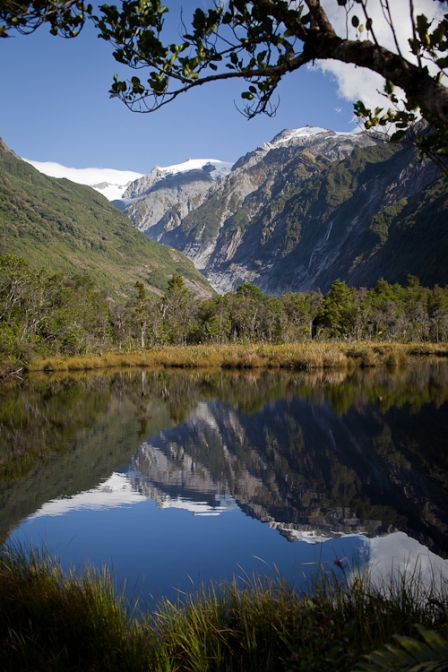
Though this display (below) was erected to explain how this “kettle pool” would one day be filled in by encroaching vegetation and soil I found its pictures more of a commentary on the diminishing size of the ice sheet which is prominently seen in the photos but which we could only see a glimpse of from this vantage point.
“Poor little glacier” was right. Its tongue, split in two like a serpent, it was riddled with dirty ice and rocks. It was hardly the majestic sheet of ice that was represented on the postcards I’d just bought.
Our hope was to see the glacier in the glow of sunset but realizing that the mountains were going to block the sun long before it set we hurried down to the Glacier Valley Walk trail. It took us about forty-five minutes to reach the end of the trail where we were stopped by the stern-faced “ranger” warning us of the dangers of going any closer. Granted we were only seeing the face of its 12 km of length but it hardly seemed worth writing home about.
According to a 2007 report, glaciologists predict the tongue of the Franz Josef could be completely gone in less than 100 years. “Even with the minimum amount of likely warming over the next century, the glacier will shrink in length by 4 km, and reduce in size to three-quarters of its current volume.” says Dr Brian Anderson from Victoria University.” On a related note, I discovered that New Zealand has kept their own measurement of the amount of carbon dioxide in the atmosphere much like that of the Keeling Curve recorded at Mauna Loa observatory in Hawaii (see my last blog post on Hawaii for more info).
The next day we headed to the 8 km Fox Glacier to see if it fared any better. The face of it looked healthier but neither of these glaciers could compare with the ones I had seen in Patagonia in December (more on them in a future post). I chatted with one couple from the curiously-named Doubtful Bay in the North Island who said they had been there just five years before and were surprised by how much smaller it was now. They said they knew it was melting fast because during their last visit there were chunks of ice as large as cars breaking off and flowing downstream in the Fox River.
According to the National Institute of Water and Atmospheric Research the volume of ice in New Zealand’s glaciers have declined approximately 50% over the last century, while the country’s average temperature has increased by about 1° Celsius.
This chart from the US Geological Survey shows that the retreats of the glaciers are definitely outweighing any recent advances. I wonder if I come back in twenty or even ten years if any ice will be visible from the valley trails. We could have paid about $400 to get a bird’s eye view from a helicopter and/or take a trek further back on the top of the glacier but with my backpacker’s budget this free hike was our only option. And truth be told, even though there might be more ice farther up the valley – what can be seen from a worm’s eye view should be enough to give anyone cause for concern.
The same “ranger” that we’d seen at the base of the Franz Josef was hanging out at the Fox Glacier the day we went (He seems to be everywhere in these parks!) I told him I was concerned about the rapid retreat of New Zealand’s glaciers. He agreed it’s a sad story what’s happening to the world around us due to climate change. But he gave me a pat on the back for the work I am doing with “The Witness Tree” to spread the news to everyone that we need to take care of this world since she’s the only one we’ve got!







